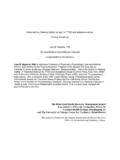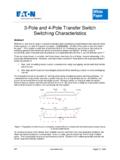Transcription of High resistance 600 Vac grounding systems - Eaton
1 high resistance600 Vac grounding systemsC-HRG NEMA 3R EnclosureNEMA 1 Enclosure2 Eaton CORPORATION C-HRG Effects of a ground fault on an ungrounded systemWhen a ground fault occurs on an ungrounded system , high transient overvoltages can occur, which may cause more frequent equipment failures than if the system were grounded. These transient overvoltages, as high as four times normal voltage, reduce the life of the system s insulation, resulting in: Motor failure Transformer failure Coil failure Electronic equipment failure Cable insulation failureTo quote the IEEE Greenbook (IEEE Std, 142-1982):The decision to convert an existing ungrounded system to grounded operation is usually made for the purpose of limiting transient overvoltages.
2 Older systems with cables, and motor and transformer windings that have degraded insulation levels due to aging, atmospheric conditions, and sustained overvoltages, are particularly vulnerable to failure due to transient overvoltages resulting from arcing ground faults. Therefore, the cost for converting to grounded operation is small when compared to the cost of possibly having to replace cables or rewind motors or that insulation degradation is cumulative for most equipment. Every time equipment is exposed to a high overvoltage transient, some amount of operating life is lost.
3 In addition, failure to locate and clear the first ground leaves the system operating with the ground present potentially very dangerous if a second ground occurs, causing a phase-to-phase service continuity by minimizing the damage due to ground faultIn an effort to improve the continuity of service to critical processes, system designers sometimes use ungrounded distribution systems to avoid interrupting service due to a ground fault. However, this subjects the distribution system to harmful effects that a ground fault causes on an ungrounded system .
4 In addition, the issue of locating the ground fault is often left CORPORATION C-HRG Locating faultsThe first ground fault on an underground system does not open a circuit breaker; therefore, detecting the source of the ground fault can be difficult. A three light system is often used to detect the presence of a ground fault. This approach does not offer any protection from the high transient overvoltages that are associated with the ground fault, nor does it help to locate the fault other than showing which phase is grounded. Locating the fault usually requires the maintenance personnel to open one breaker at a time until the faulted circuit is isolated.
5 This method is time-consuming, and often will require service interruptions to many areas of the facility. When dealing with the first ground, time is crucial. The fault must be eliminated before the potentially catastrophic second ground can occur. What maintenance needs, therefore, is a coordinated system that both detects the ground and assists in its location quickly and the question becomes, How do we locate, correct and minimize the effects when a grounded fault occurs?A possible solutionThere is a solution to the problem of balancing service continuity against transient overvoltage and that is high resistance grounding .
6 The grounding resistor eliminates the high voltage transients, but at the same time it allows only a small ground current to flow. This small current (typically 5A) is not high enough to cause damage; moreover, it aids in the effort required to locate the fault, usually with little or no service better way high resistance groundingBy utilizing a high resistance grounding system , many facilities can gain the benefit of a grounding system without impairing the continuity of service to their equipment. The concept behind high resistance grounding is to provide a path for the ground current flow while limiting its magnitude by using a resistor.
7 The ground current path is provided at the point where service begins. Control equipment continuously monitors the magnitude of the ground current. When the ground current exceeds a predetermined level, the built-in alarm relay alerts building personnel that ground fault exists. In addition, the system has a built-in fault tracing means to assist in finding the source of the ground fault without interrupting requirementsPer NEC 2005, , high resistance grounding systems can be applied to either grounded or ungrounded three-wire distribution s 600V class high resistance grounding systemsDS-VSRM otorStarter200 hpMotor LoadsMMMMCCBus DuctFeederBreakerFeederBreakerFeederBrea kerConduitConduitCable TrayCCDistributionSwitchboardTransformer 4 WPanel-boardMisc.
8 3W LoadsMain Breaker600V (Max)HVHVHVC-HRG high ResistanceGroundingSystemSourceSystemTra nsformerTypical C-HRG LocationC-HRG is offered as a freestanding unit or integrated into Eaton s low voltage CORPORATION C-HRG Clamp-on detectorThe current pulses that the pulsing circuit provides can be displayed using a clamp-on detector. The detector is placed around all three phases and is used to trace the pulses to the origin of the ground fault. otes: NWhile the pulser can greatly aid in locating a fault, there may be certain conditions under which the pulses cannot be readily traced and other test procedures (megohm, high -potential, and the like) may be needed.
9 (Catalog number 23600 GFS order separately.)Ammeter and overcurrent relayThe amount of ground fault current flowing through the system is continuously monitored by an ammeter and an overcurrent relay. When a ground fault current exceeds the overcurrent relay set point, the ground alarm circuit is activated. By recording the ammeter readings over time, trends can be developed, and the integrity of the system s insulation can be : NVoltmeter relay is an option.(Included in base catalog number see page 7.)Neutral grounding resistorThe resistor in a high resistance grounding system is used to limit the amount of ground fault current that can flow.
10 The C-HRG system uses multiple tap resistor bank, which will limit the ground current to values of 1, 2, 3, 4 or 5 amperes.(Included in base catalog number see page 7.) Pulser circuitThe pulser circuit offers a convenient means to locate the faulted feeder and trace the fault to its origin. The pulser is available any time a fault has been detected. The pulse light flashes on and off, corresponding to the ON-OFF cycles of the pulser contactor. The pulser contactor switches a bank of resistors on and off, allowing a momentary increase in the ground current.
















